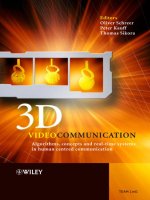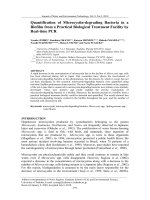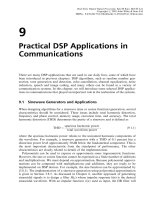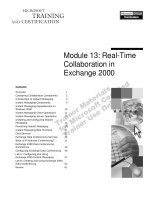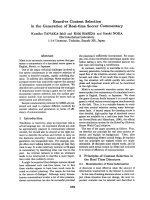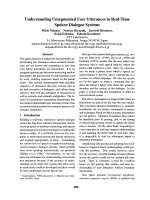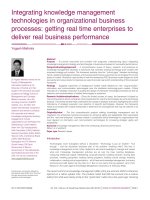Real time energy consumption measurements in data centers
Bạn đang xem bản rút gọn của tài liệu. Xem và tải ngay bản đầy đủ của tài liệu tại đây (7.62 MB, 297 trang )
©2009, American Society of Heating, Refrigerating and Air-Conditioning Engineers, Inc. (www.ashrae.org).
For personal use only. Additional reproduction, distribution, or transmission in either print or
digital form is not permitted without ASHRAE's prior written permission.
©2009, American Society of Heating, Refrigerating and Air-Conditioning Engineers, Inc. (www.ashrae.org).
For personal use only. Additional reproduction, distribution, or transmission in either print or
digital form is not permitted without ASHRAE's prior written permission.
’
Any updates/errata to this publication will be posted on the
ASHRAE Web site at www.ashrae.org/publicationupdates.
©2009, American Society of Heating, Refrigerating and Air-Conditioning Engineers, Inc. (www.ashrae.org).
For personal use only. Additional reproduction, distribution, or transmission in either print or
digital form is not permitted without ASHRAE's prior written permission.
©2009, American Society of Heating, Refrigerating and Air-Conditioning Engineers, Inc. (www.ashrae.org).
For personal use only. Additional reproduction, distribution, or transmission in either print or
digital form is not permitted without ASHRAE's prior written permission.
ISBN 978-1-933742-73-1
©2009 American Society of Heating, Refrigerating
and Air-Conditioning Engineers, Inc.
1791 Tullie Circle, NE
Atlanta, GA 30329
www.ashrae.org
All rights reserved.
Printed in the United States of America
Cover design by Joe Lombardo, DLB Associates.
ASHRAE has compiled this publication with care, but ASHRAE has not investigated,
and ASHRAE expressly disclaims any duty to investigate, any product, service, process,
procedure, design, or the like that may be described herein. The appearance of any
technical data or editorial material in this publication does not constitute endorsement,
warranty, or guaranty by ASHRAE of any product, service, process, procedure, design, or
the like. ASHRAE does not warrant that the information in the publication is free of
errors, and ASHRAE does not necessarily agree with any statement or opinion in this
publication. The entire risk of the use of any information in this publication is assumed
by the user.
No part of this book may be reproduced without permission in writing from ASHRAE,
except by a reviewer who may quote brief passages or reproduce illustrations in a review
with appropriate credit; nor may any part of this book be reproduced, stored in a retrieval
system, or transmitted in any way or by any means—electronic, photocopying, recording,
or other—without permission in writing from ASHRAE. Requests for permission should
be submitted at www.ashrae.org/permissions.
____________________________________________
©2009, American Society of Heating, Refrigerating and Air-Conditioning Engineers, Inc. (www.ashrae.org).
For personal use only. Additional reproduction, distribution, or transmission in either print or
digital form is not permitted without ASHRAE's prior written permission.
Acknowledgments.......................................................................... ix
PART 1 BASICS
CHAPTER 1 INTRODUCTION................................................ 3
1.1 Objectives for this Book ............................................................. 11
1.2 How to Use this Book ................................................................ 12
CHAPTER 2 HOW, WHAT, & WHERE TO MEASURE ... 15
2.1 Overview ..................................................................................... 15
2.2 Quantifying Energy Efficiency Metrics .................................. 17
CHAPTER 3 MEASUREMENT DEVICES ........................... 21
3.1 Overview ..................................................................................... 21
3.2 Sensor Accuracy ......................................................................... 23
3.3 Temperature ................................................................................ 24
3.4 Pressure ........................................................................................ 29
3.5 Flow—Liquid .............................................................................. 31
3.6 Flow—Gas ................................................................................... 40
3.7 Current ......................................................................................... 44
3.8 Voltage ......................................................................................... 49
3.9 Power ........................................................................................... 53
CHAPTER 4 MEASUREMENT COLLECTION
SYSTEMS—ARCHITECTURE & SOFTWARE ........... 59
4.1 Overview ..................................................................................... 59
4.2 Business Questions..................................................................... 60
4.3 Scalable Hardware/Software Architecture .............................. 63
4.4 Measurement Levels .................................................................. 64
v
©2009, American Society of Heating, Refrigerating and Air-Conditioning Engineers, Inc. (www.ashrae.org).
For personal use only. Additional reproduction, distribution, or transmission in either print or
digital form is not permitted without ASHRAE's prior written permission.
Real-Time Energy Consumption Measurements in Data Centers
PART 2
COOLING SYSTEMS—AIR MEASUREMENTS
CHAPTER 5 AIR HANDLERS ............................................... 79
5.1 Overview ..................................................................................... 79
5.2 Measurement Levels .................................................................. 81
CHAPTER 6 COMPUTER ROOM UNITS ........................... 85
6.1 Overview ..................................................................................... 85
6.2 Measurement Levels .................................................................. 94
PART 3
COOLING SYSTEMS
—HYDRONIC MEASUREMENTS
CHAPTER 7 PUMPS .............................................................. 101
7.1 Overview ................................................................................... 101
7.2 Measurement Levels—Electrical............................................ 101
7.3 Measurement Levels—Fluid ................................................... 105
CHAPTER 8 COOLING TOWERS...................................... 113
8.1 Overview ................................................................................... 113
8.2 Measurement Levels ................................................................ 116
CHAPTER 9 CHILLERS ....................................................... 125
9.1 Overview ................................................................................... 125
9.2 Measurement Levels ................................................................ 129
CHAPTER 10 HEAT EXCHANGERS ................................... 141
10.1 Overview ................................................................................... 141
10.2 Measurement Levels ................................................................ 143
PART 4
POWER SYSTEMS MEASUREMENTS
CHAPTER 11 INTRODUCTION TO
CRITICAL POWER DISTRIBUTION ......................... 149
11.1 Overview ................................................................................... 149
11.2 Critical Power versus Essential Power .................................. 150
vi
©2009, American Society of Heating, Refrigerating and Air-Conditioning Engineers, Inc. (www.ashrae.org).
For personal use only. Additional reproduction, distribution, or transmission in either print or
digital form is not permitted without ASHRAE's prior written permission.
Contents
CHAPTER 12 UPSTREAM CRITICAL
POWER DISTRIBUTION .............................................. 155
12.1 Overview ................................................................................... 155
12.2 Service Entrance Equipment ................................................... 155
12.3 Automatic Transfer Switch (ATS) ......................................... 159
12.4 Primary Electrical Distribution Switchgear .......................... 161
CHAPTER 13 UNINTERRUPTIBLE
POWER SUPPLY (UPS) ................................................. 165
13.1 Overview ................................................................................... 165
13.2 UPS Metering, Power Module Level ..................................... 168
13.3 UPS Metering, System Level.................................................. 169
CHAPTER 14 COMPUTER ROOM TRANSFORMER
& POWER DISTRIBUTION UNIT (PDU) ................... 173
14.1 Overview ................................................................................... 173
14.2 Stand-Alone Transformers ...................................................... 173
14.3 Computer Room Power Distribution Units (PDU) .............. 175
14.4 Rack-Mounted Power Distribution Unit (RPDU) ................ 179
PART 5
IT SYSTEMS MEASUREMENTS
CHAPTER 15 COMPUTE & STORAGE SYSTEMS........... 185
15.1 Overview ................................................................................... 185
15.2 Measurement Levels ................................................................ 190
CHAPTER 16 NETWORKING SYSTEMS ........................... 201
16.1 Overview ................................................................................... 201
16.2 Measurement Levels ................................................................ 206
APPENDIX A PUMPS .................................................................... 213
A.1 Power and Efficiency ......................................................... 213
A.2 Real-Time Power Measurements ....................................... 216
vii
©2009, American Society of Heating, Refrigerating and Air-Conditioning Engineers, Inc. (www.ashrae.org).
For personal use only. Additional reproduction, distribution, or transmission in either print or
digital form is not permitted without ASHRAE's prior written permission.
Real-Time Energy Consumption Measurements in Data Centers
APPENDIX B CHILLERS ............................................................ 223
B.1 Variables Affecting RLA and Power Rating ......................... 223
B.2 Integrated or Non-Standard Part Load Value ..................... 224
APPENDIX C MIXED-USE FACILITIES................................ 227
C.1 Real-Time Cooling Tower Power Consumption ................ 227
C.2 Real-Time Chiller Power Consumption ............................. 229
APPENDIX D UNINTERRUPTIBLE
POWER SUPPLY (UPS) ...................................................... 233
D.1 Technology ......................................................................... 234
D.2 Redundancy and Availability ............................................. 236
D.3 Rules of Thumb for Minimum Practical Level
of UPS Instrumentation ...................................................... 241
D.4 Sample Case Study: A Partial PUE and DCiE Determination
for the Critical Power Path within the Data Center ............ 243
APPENDIX E ONSITE POWER GENERATION
AND CCHP IN DATA CENTER APPLICATIONS ..... 249
E.1 Overview ............................................................................ 249
E.2 CCHP.................................................................................. 251
E.3 Measurement Levels........................................................... 258
E.4 Example Calculations for a CCHP Installation ..................... 263
APPENDIX F ABBREVIATIONS AND GLOSSARY ........... 267
REFERENCES ................................................................................... 283
viii
©2009, American Society of Heating, Refrigerating and Air-Conditioning Engineers, Inc. (www.ashrae.org).
For personal use only. Additional reproduction, distribution, or transmission in either print or
digital form is not permitted without ASHRAE's prior written permission.
ASHRAE TC 9.9 and The Green Grid would like to thank the
following individuals for their substantial contributions to the
book:
Lead editor / author – Tahir Cader, HP (formerly SprayCool)
Co-editor after First Draft – Don Beaty, DLB Associates
Chapter 1 – Tahir Cadera,b, HP (lead)
Chapter 2 – Tahir Cadera,b, HP (lead); Mike Mangan, DLB
Associates; Jeff Jaworksi, DLB Associates
Chapter 3 – John Beana,b, APC/Schneider; Randall Woffordb, Dell;
Ross Ignalla, Dranetz-BMI; Michael Kennedy, DLB Associates
Chapter 4 – Ken Uhlmanb, Eaton (lead); Harry Rogersb, Microsoft
Chapter 5 – Robert Wasilewski, DLB Associates (lead)
Chapter 6 – Jeff Trowera, DataAire (lead); Cliff Federspiel,
Federspiel Controls
Chapter 7 – John Beana,b, APC/Schneider (lead)
Chapter 8 – Daryn Clinea, Evapco (lead)
Chapter 9 – Jonathan Spreemana, Trane (lead); Tahir Cadera,b, HP
Chapter 10 – Robert Wasilewski, DLB Associates
Chapters 11, 12, 13, 14 – Steve McCluera,b, APC/Schneider
Electric (lead); Bill Campbellb, Emerson Network Power; John
Messerb, Emerson Network Power
Chapter 15 – Mike Pattersona,b, Intel (lead); Bob MacArthurb,
EMC
Chapter 16 – Kevin Engelberta,b, Cisco (lead)
Chapter 17 – Kevin Wymana, Carrier Corporation (lead); Greg
Palmerb, HP (formerly UTC Power) (lead);
Appendix A – John Beana,b, APC/Schneider (lead)
Appendix B – Jonathan Spreemana, Trane (lead)
Appendix C – Tahir Cadera,b, HP (lead); Jonathan Spreemana,
Trane
ix
©2009, American Society of Heating, Refrigerating and Air-Conditioning Engineers, Inc. (www.ashrae.org).
For personal use only. Additional reproduction, distribution, or transmission in either print or
digital form is not permitted without ASHRAE's prior written permission.
Real-Time Energy Consumption Measurements in Data Centers
Appendix D – Steve McCluera,b, APC/Schneider (lead); Bill
Campbella, Emerson Network Power; John Messerb, Emerson
Network Power
Appendix E – Kevin Wymana, Carrier Corporation; Greg Palmera,b,
HP (formerly UTC Power) (lead);
The following individuals also provided significant feedback and
guidance in the writing of this book: Roger Schmidt, IBM; Don
Beaty, DLB Associates (major commenter on 1st edition).
Production of final book including creation of most graphics – Jeff
Jaworski, DLB Associates; Mike Mangan, DLB Associates.
Book cover design – Joe Lombardo, DLB Associates.
a
b
Member ASHRAE TC 9.9
Member The Green Grid
x
©2009, American Society of Heating, Refrigerating and Air-Conditioning Engineers, Inc. (www.ashrae.org).
For personal use only. Additional reproduction, distribution, or transmission in either print or
digital form is not permitted without ASHRAE's prior written permission.
©2009, American Society of Heating, Refrigerating and Air-Conditioning Engineers, Inc. (www.ashrae.org).
For personal use only. Additional reproduction, distribution, or transmission in either print or
digital form is not permitted without ASHRAE's prior written permission.
©2009, American Society of Heating, Refrigerating and Air-Conditioning Engineers, Inc. (www.ashrae.org).
For personal use only. Additional reproduction, distribution, or transmission in either print or
digital form is not permitted without ASHRAE's prior written permission.
Over the last several years, energy consumption by data centers in
the US as well as worldwide has become a topic of intense discussion
within the Information and Communication Technologies (ICT) world.
There are numerous publications presenting statistics on the impact of
data center power consumption on the supply of electricity. One of the
more comprehensive studies was that requested by the US Congress in
Public Law 109-431, in which the EPA was mandated to quantify the
electricity usage by US data centers, resulting in Report to Congress on
Server and Data Center Energy Efficiency Public Law 109-431, 2007.
The key finding of this study is that in 2006, US data centers consumed
1.5% of all electricity used in the US and that according to historical
trends, this consumption would rise to 2.9% by 2011. The 1.5%
electricity usage included servers and the infrastructure to support
servers, but did not include network or storage equipment. A graph of
the findings is shown in Figure 1.1.
3
©2009, American Society of Heating, Refrigerating and Air-Conditioning Engineers, Inc. (www.ashrae.org).
For personal use only. Additional reproduction, distribution, or transmission in either print or
digital form is not permitted without ASHRAE's prior written permission.
Real-Time Energy Consumption Measurements in Data Centers
Figure 1.1 - Projected data center
energy use scenarios (EPA, 2007)
The alarming trend of escalating electricity consumption in US data
centers has spurred the ICT industry to aggressively increase energy
efficiency in order to dramatically reduce power consumption in data
centers. Together, the DOE and The Green Grid have stated that a goal
for 2011 is to achieve a reduction of energy to 100B kWh / year instead
of the current projection of 120B kWh / year for 2011. One of the key
ways in which the industry can achieve the state-of-the-art curve is via
real-time energy efficiency, which is achievable only through the use of
4
©2009, American Society of Heating, Refrigerating and Air-Conditioning Engineers, Inc. (www.ashrae.org).
For personal use only. Additional reproduction, distribution, or transmission in either print or
digital form is not permitted without ASHRAE's prior written permission.
Introduction
real-time energy consumption data using energy efficiency and
productivity metrics. An example of a real-time energy efficiency metric
is the real-time version of the Power Utilization Effectiveness (PUE)
metric as proposed by The Green Grid (Green Grid Data Center Power
Efficiency Metrics: PUE And DCiE, 2008). This metric is defined and
discussed further in Chapter 2. The focus of this book is real-time
energy consumption measurements, with the resulting data to be used in
all the relevant energy efficiency and productivity metrics.
Real-time energy consumption measurements are only possible if all
key subsystems are appropriately instrumented and properly
communicating through use of data center level software. Existing data
centers have varying levels of instrumentation, ranging from very poor to
excellent. For this book, three approaches to instrumentation and
measurement for any given subsystem will be followed. The following
loose guidelines are provided:
Minimum Practical Measurement
Best Practical Measurement
State-of-the-Art Measurement
When deciding what level of measurement to target, a data center
owner / operator needs to keep in mind key items such as capital cost,
data accuracy and resolution, and end-use of the data. These factors will
be dealt with in further detail in subsequent chapters. The following
guidelines, summarized in Table 1.1, are suggested:
Minimum Practical Measurement – This will require some level of
human activity to perform periodic measurements. This approach
will require zero to limited infrastructure upgrades, and zero to
limited investment in instrumentation. This approach may rely more
heavily on staff (most likely existing) to manually record data, and
will also rely on manufacturers’ equipment data.
Best Practical Measurement – This will require a lower level of
human activity than the minimum case in order to manually record
data. For this case, it is anticipated that data will be logged in realtime with extensive trending possible. The instrumentation used
may not necessarily be of the highest accuracy nor will it likely be
5
©2009, American Society of Heating, Refrigerating and Air-Conditioning Engineers, Inc. (www.ashrae.org).
For personal use only. Additional reproduction, distribution, or transmission in either print or
digital form is not permitted without ASHRAE's prior written permission.
Real-Time Energy Consumption Measurements in Data Centers
the most extensive, with the more difficult to instrument parts of the
facility remaining uninstrumented.
Limited modification to
infrastructure should be expected, and some tasks may be beyond the
competency of the existing staff. Less reliance on manufacturers’
data is expected.
State-of-the-Art Measurement – This will not require human activity
to gather and record data. Data will be collected by automated
systems in real-time and will support extensive trending and analysis.
The instrumentation will be of accuracy suitable for revenue grade.
There will likely be a requirement to upgrade the existing
infrastructure, and it is very likely some level of contractor or
consultant support will be needed for the implementation.
Mixed-use facilities offer the greatest challenge in which to quantify
real time energy consumption. Figures 1.2 through 1.4 show a generic
layout in a mixed-use facility. These figures are schematic in nature and
are not intended to be fully representative of all possible configurations.
Figure 1.2 shows a schematic representation of the electrical distribution
system in a mixed-use data center, while Figure 1.3 shows the
mechanical layout of the same data center type.
6
©2009, American Society of Heating, Refrigerating and Air-Conditioning Engineers, Inc. (www.ashrae.org).
For personal use only. Additional reproduction, distribution, or transmission in either print or
digital form is not permitted without ASHRAE's prior written permission.
Introduction
Figure 1.2 - Schematic representation
of the electrical system in a mixeduse facility
7
©2009, American Society of Heating, Refrigerating and Air-Conditioning Engineers, Inc. (www.ashrae.org).
For personal use only. Additional reproduction, distribution, or transmission in either print or
digital form is not permitted without ASHRAE's prior written permission.
Real-Time Energy Consumption Measurements in Data Centers
Figure 1.3 - Schematic representation
of the mechanical layout of a data
center housed in a mixed-use facility
8
©2009, American Society of Heating, Refrigerating and Air-Conditioning Engineers, Inc. (www.ashrae.org).
For personal use only. Additional reproduction, distribution, or transmission in either print or
digital form is not permitted without ASHRAE's prior written permission.
Introduction
Figure 1.4 is a simple graphic representing the key metering
locations in a typical data center.
The meters acquire power
consumption data from all the electrical and mechanical subsystems
shown in Figures 1.2 and 1.3, respectively. Each metering location is
associated with its own hardware and software protocols, and in many
cases hardware and software is provided by multiple vendors. These
systems generally do not communicate with each other, which creates a
significant issue in progressing toward the display of real-time energy
and productivity metrics. The subsequent chapters will discuss these
issues in further detail.
9
©2009, American Society of Heating, Refrigerating and Air-Conditioning Engineers, Inc. (www.ashrae.org).
For personal use only. Additional reproduction, distribution, or transmission in either print or
digital form is not permitted without ASHRAE's prior written permission.
Real-Time Energy Consumption Measurements in Data Centers
Figure 1.4 - Key metering locations in
a data center
10
©2009, American Society of Heating, Refrigerating and Air-Conditioning Engineers, Inc. (www.ashrae.org).
For personal use only. Additional reproduction, distribution, or transmission in either print or
digital form is not permitted without ASHRAE's prior written permission.
Introduction
1.1
OBJECTIVES FOR THIS BOOK
The following are key objectives for the book:
Provide an overview of the state of real-time energy consumption
measurements in the data center. The book will cover both legacy as
well as state-of-the-art data centers.
Discuss the minimum and best practical levels of measurement, as
well as state-of-the-art measurement for real-time energy
consumption measurements (see Chapter 1 – Introduction).
Provide a detailed discussion of how the measured real-time data
will be used, and in particular how this information will be turned
into knowledge that can lead to actionable items. This will cover the
latest industry data center productivity and energy efficiency metrics
from organizations such as The Green Grid and ASHRAE TC9.9.
Emphasis will also be placed on quantifying the data center’s power
consumption for a data center housed in a mixed-use facility.
The idea behind the state-of-the-art measurement is that the industry
will eventually arrive at the ―plug and play‖ data center. Such a data
center will rely on the widespread availability of network-enabled
equipment. For example, at some point in the future, a data center owner
/ operator can expect to ―plug in‖ a key subsystem such as a pump and
have the data center’s operating system recognize the pump in real-time.
This will be followed shortly thereafter by real-time reporting of energy
consumption measurements, and in turn real-time data center
productivity and energy efficiency metrics.
This book will focus on monitoring and control for optimization of
data center energy efficiency. There are, in fact, other benefits that may
arise from real-time monitoring and control. One key benefit includes
predicting the health of the infrastructure by tracking performance trends.
Additionally, while the book presents several examples using the
Power Usage Effectiveness (PUE) metric from The Green Grid, use of
any specific metric such as the DOE’s Energy Usage Effectiveness
(EUE), or The Green Grid’s Data Center Energy Productivity (DCeP) is
left entirely up to the data center owner / operator.
11
©2009, American Society of Heating, Refrigerating and Air-Conditioning Engineers, Inc. (www.ashrae.org).
For personal use only. Additional reproduction, distribution, or transmission in either print or
digital form is not permitted without ASHRAE's prior written permission.
Real-Time Energy Consumption Measurements in Data Centers
1.2
HOW TO USE THIS BOOK
While it is recommended that this book be read in its entirety, it is
possible to benefit from reading only parts of the book. For the benefit
of the reader, the book has been divided into five parts, each containing
chapters dedicated to key components or subsystems. The five parts
included are:
Part 1
Part 2
Part 3
Part 4
Part 5
Basics
Cooling Systems – Air Measurements
Cooling Systems – Hydronic Measurements
Power Systems Measurements
IT Systems Measurements
Part 1 will provide an overview of the book including measurement
devices and software. Chapter 1 sets the stage for the book. Chapter 2
will focus on How, What & Where To Measure. Chapter 3, the
Measurement Devices chapter, will provide an overview of the various
sensor types available. The chapter will provide an overview of sensors
for all electrical (e.g., voltage, current, etc.) and mechanical (e.g.,
pressure, temperature, flow, etc.) systems in the data center. Chapter 4,
the Measurements Collection Systems chapter, will cover the business
objectives that will guide a data center owner / operator to a given level
of instrumentation (i.e., minimum practical, best practical, or state-ofthe-art level of measurement). This chapter will also provide an
overview of the various standards and protocols to facilitate
communication with IT equipment and facilities equipment. The
objective of such protocols is to acquire the real-time power consumption
data and make it readily available to the data center owner / operator.
Finally, this chapter will provide some discussion of how the acquired
and reduced data can be turned into knowledge and subsequent
actionable items that affect the business.
Parts 2 and 3 will provide an overview of the various cooling
systems and subsystem types (e.g., chillers) that are deployed today.
Each chapter will focus on the single most widely deployed subsystem
type and provide a more detailed discussion of the three levels of
instrumentation. The reader will be shown a high level discussion (not a
detailed description) of how to, at each level of instrumentation, use
12
©2009, American Society of Heating, Refrigerating and Air-Conditioning Engineers, Inc. (www.ashrae.org).
For personal use only. Additional reproduction, distribution, or transmission in either print or
digital form is not permitted without ASHRAE's prior written permission.
Introduction
measured data and manufacturer’s data to quantify the power
consumption of the specific subsystem type. Special attention is given,
where appropriate, to show the reader how to quantify that part of the
subsystem’s power consumption that is attributable to a data center
housed in a mixed-use facility. For example, in mixed-use facilities, the
cooling towers, chillers, and pumps typically support all parts of the
facility, including the data center.
Part 4 will focus on the power delivery path from the point of entry
into the facility, to the point of delivery to the IT equipment. Specific
attention is paid to Uninterruptible Power Supplies (UPS) and
transformers. As with the other chapters, an overview is provided with
emphasis on the most widely deployed UPSs and transformers.
Part 5 will provide a description of the servers, storage, and
networking equipment deployed in data centers. The three levels of
instrumentation will be discussed, and the reader will be shown how to
roll the total IT equipment power consumption into a single power
consumption number for later use by the data center owner / operator.
There are also Appendices meant to provide additional information
or detail for different subsystems or components. Appendix A provides
additional information for calculating real-time pump efficiency.
Appendix B describes additional methods for quantifying chiller
efficiency. Appendix C focuses on a specific example for calculations
within a mixed-use facility. Appendix D provides additional information
on Uninterruptible Power Supply efficiency measurements. Some ruleof-thumb calculations are also provided to enable the reader to perform
calculations on power conversion losses. Appendix E, Onsite Combined
Cooling, Heat, and Power (CCHP), describes in some detail the specifics
of CCHP and waste heat recovery. An important feature of the chapter is
the description of how to accommodate CCHP within the calculation of
energy efficiency metrics such as PUE for data centers. Appendix F lists
the nomenclature in the book.
A references section is located at the end of the book.
13
©2009, American Society of Heating, Refrigerating and Air-Conditioning Engineers, Inc. (www.ashrae.org).
For personal use only. Additional reproduction, distribution, or transmission in either print or
digital form is not permitted without ASHRAE's prior written permission.
